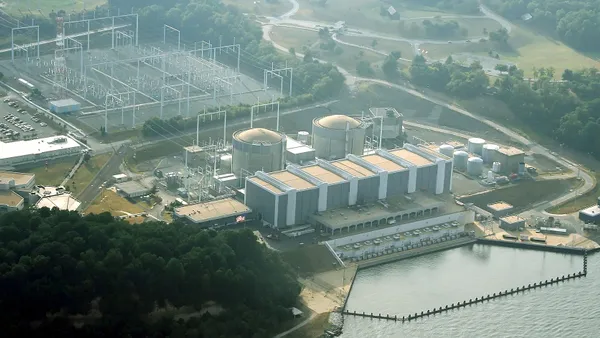While most other Southeastern utilities are still hesitant about solar and wind, Southern Company subsidiary Georgia Power is rapidly adding renewables to its portfolio.
By the end of 2016, Georgia Power will have nearly 900 megawatts of solar-generated electricity on its grid and will be delivering some 250 megawatts of wind-generated electricity. Does it know something its neighbors don’t?
How Georgia Power grew to love solar
“In the early 2000s, we saw the growing interest from customers, regulators, and advocates for more renewable energy, leading us to develop and launch our voluntary Green Energy program,” explained Georgia Power Spokesperson John Kraft.
But “rather than rush into renewables at any cost with expensive, unproven technology,” Kraft added, Georgia Power insisted on “research, economics and a customer focus.”
The utility's 2007 IRP included “three renewables projects of up to 30 megawatts at a price not to exceed our avoided cost,” recalled Georgia Power Renewable Generation Manager Ervan Hancock. “At the time we were thinking of biomass.” But biomass, they discovered, had cost and emissions challenges.
Meanwhile, solar’s price dropped and its popularity with regulators and customers rose. Participation in Georgia Power’s voluntary green energy program’s premium option, which included 50% solar for a monthly bill surcharge of $5.00 per 100 kilowatt-hours, increased.
A 30-month onsite comparison of seven PV module technologies, done in partnership with the Electric Power Research Institute (EPRI) on the roof of Georgia Power headquarters, created a better understanding of rooftop solar, the local solar resource, and its delivered energy potential.
They obtained power output data, monthly insolation, irradiance profiles, and variability metrics that showed annual and seasonal capacity factors, monthly performance, seasonal peaks, and 15-minute and hourly time-of-day profiles.
Georgia Power discovered solar’s main impact is “around midday,” Kraft said. “It is a valuable resource in our summer peak season but its production peaks around 1PM and falls off a lot at the 5PM to 6PM daily peak.” They also learned that Georgia solar’s best production is in the spring and fall when ample midday sun but cooler temperatures keep modules at near maximum efficiency.
“In 2011, we took the biggest step to that time,” Kraft said, “with a commitment to procure 50 megawatts of solar.”
In 2012, the utility introduced its first Advanced Solar Initiative (ASI), a commitment to procure 210 megawatts in residential, commercial/industrial, and utility-scale twenty-year contracts.
And in the 2013 IRP proceedings, regulators proposed a second ASI for 525 megawatts. The utility assented, Kraft said, “when we were certain it could be implemented.”
They initiated the 2012 ASI last year and expect to complete allocations this year. The bidding price for small- and medium-scale installations was set at $0.13 per kilowatt-hour for twenty year contracts, Kraft said, and utility-scale twenty year contract bids were capped at $0.12 per kilowatt-hour. Unsubscribed amounts in all categories were rolled into last year’s RFPs.
This year, Georgia Power began implementing the 2013 ASI with a new RFP. Bidding is now closed, with all categories fully subscribed. Bids are still being evaluated.
Why Georgia Power's solar initiative is a 'big deal'
Georgia Power just announced it will finance, build, own, and operate three 30 megawatt solar PV projects with the U.S. Army as offtaker. The Georgia 3x30 initiative will fulfill the original 2007 commitment with solar instead of biomass. More importantly, the twenty year General Services Agreement contract with the Army is at prices “at or below our avoided cost so they will not put upward pressure on our rates,” Hancock said.
“That’s a big deal, especially deep in coal country,” observed Vote Solar Executive Director Adam Browning.
“90 megawatts of new solar is a big deal in a state that had eight megawatts total in 2011,” added Georgia Solar Energy Industries Jason Rooks.
It is even more of a big deal because it could change the debate about solar’s value. If its levelized cost now meets or beats utilities’ avoided cost according to their least cost, best fit parameters for traditional generation, the debate is over.
“Our avoided cost calculation in our most recent filing with the PSC was between $0.085 per kilowatt-hour and $0.09 per kilowatt-hour and we concluded the cost of generating from solar would be at that or lower,” Hancock said. “In our most recent utility-scale solar RFP, the average bid was $0.085 per kilowatt-hour.”
All ASI development will be completed by the end of 2016 to qualify for the 30% investment tax credit.
Georgia Power has “heard that our customers and regulators want us to do more solar but one of our philosophical principles is that we don’t want to increase customer charges,” Kraft said. “As we have seen drops in the cost of solar, we’ve embraced it.”
Though the price of electricity has increased, Georgia Power has kept its rates “below the national average.”
The utility has also maintained “a diversified portfolio of resources to ensure reliability” that includes 250 megawatts of wind imported from Oklahoma, Kraft said. And despite the fact that “we now have more capacity than we need because of the decreased demand for electricity that followed the last economic downturn,” he explained, “we are a national leader in the pursuit of new nuclear” as work continues, supported by a DOE loan guarantee, on the controversial Vogtle facility.
But as Kraft reminded, Georgia Power still has "a lot of work to do to get that solar online by the end of 2016.”





















